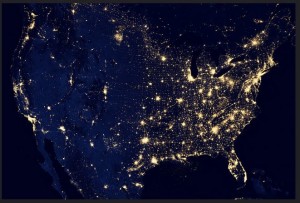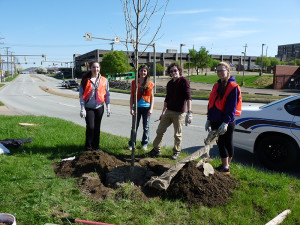In Bill Bryson’s wonderful book, A Walk in The Woods, he marvels at the large percentage of the American landmass that is still in (or has returned to) forest. The World Bank sets this percentage (as of 2012) at 33.32%, and this percentage is steadily increasing. This one third of our countryside that is covered with trees is, indeed, an incredible resource and refuge not only for people but also for a myriad of plant and animal species.
But Bryson, though, misses the mark a bit when he talks about these forested lands and their potential impacts on people. Very few people actually live in these forested places and, sadly, even fewer people will actually make the effort to go out and experience them. A 2015 U.S. Census Bureau report states that 62.7% of the U.S. population lives in cities (or other incorporated areas). These cities make up 3.5% of the American land area and are recognizable even from images taken from space. These urban areas are typically places of very little tree cover. Cities, by and large, are the opposite of forests!
It is the task of city planners and managers to make a city as livable as possible for its human residents. This involves creating and maintaining a complex matrix of housing, transportation, resource delivery and waste removal systems robust enough to sustain the densely packed, city-dwelling population, and when you build streets, and houses, and buildings, and sewers, and lay water and gas pipes, and put up electric lines, you also often have to remove most of the existing trees. This generates the “un-forest” appearance of many urban areas.
Increasingly, though, city managers are recognizing the role of trees in making urban environments more conducive to healthy and sustainable human living. For example, trees help to reduce air temperatures by both blocking sunlight and also by transpiring water from their leaves (an evaporative cooling system similar to your body’s use of perspiration to cool your skin’s surface). A single tree can cool air to a comparable degree as ten, room-sized air conditioners running twenty hours a day! These cooling impacts can reduce energy consumption in the summer and also mitigate dangerous summertime “urban heat island” (UHI) effects. Researchers have documented direct connections between UHI’s event peaks and human related debilities, illnesses and even fatalities. Heat stroke, heat exhaustion, heat cramps, and aggravation of heart diseases are just a short list of these UHI impacts on people. Further, the elevated temperature of the lower atmosphere over a city can lead to the accelerated production of ozone and smog with concomitant increases in respiratory disorders and diseases including asthma (see http://www.urbanheatislands.com/ for more details).
A very nice tie-in, by the way, to planting deciduous trees in urban areas is that the cooling impacts describe above will only occur in the summer when the trees have leaves! In the winter, the bare tree branches will generate only very slight shade profiles thus allowing incoming sunlight to warm houses and buildings during the day.
What else do trees do? Trees block the wind and reduce noise and glare. They trap dust and pollen and help to both reduce the high velocity impact of raindrops on soil (a major erosive force!) and absorb surface runoff of rainstorms. One tree can make enough oxygen to supply the daily needs of four people. One tree can also store 13 tons of carbon (from carbon dioxide) per year. (Please see the Tree Vitalize Brochure (http://www.treevitalize.net/) and the North Carolina State Co-op Extension web page (https://www.ncsu.edu/project/treesofstrength/benefits.htm) from which many of these statistics have been drawn)
Planting trees in our cities, then, is a demonstrably good idea. Human health (both physical and psychological) is improved, energy consumption is reduced, and (and for many this is the big hook for this tree sales pitch) property values go up when you plant trees!
Tree Vitalize (whose brochure I mentioned previously) is a public-private partnership sponsored by the Pennsylvania Department of Conservation and Natural Resources (DCNR), It was established in 2004 with the mission of establishing (or restoring) tree cover in the cities of Pennsylvania. In the first eleven years of this program over five million dollars of DCNR grants along with over six million dollars of matching funds were awarded to groups across Pennsylvania! These funds were used to train over six thousand volunteers and resulted in the planting of almost a half a million trees!
Locally, in nearby New Kensington, Jane Glenn and the New Kensington Shade Tree Commission have secured Tree Vitalize funds to do three tree plantings along its downtown streets and out in some of its neighborhoods. In these three events (September 2014, May 2015, and November 2015) thirty-seven new trees have been successfully established! I have had the pleasure of participating in these plantings along with an energetic group of my biology students from Penn State. These trees represent a lasting legacy and a bond between our campus and the surrounding community! (This picture of four of these Penn State biology students (Aubrey, Brittany, Jason, and Alaina) standing next to one of their trees is also out on page 15 of the Tree Vitalize Brochure!) The good news is that ALL of the trees that we have planted are thriving!
One last note about cities and trees: as I was looking through some web sites about relative tree cover in large U.S. cities, I was very pleased to note that Pittsburgh ranks at the top of a large city list when it comes to tree cover. New York City, Philadelphia, Detroit and Baltimore each had tree cover percentages in the 20%’s, and Washington, D.C. had a tree cover percentage of 36%. Pittsburgh, though, topped the list with a tree cover percentage of 42% (and growing!). Not bad for a “steel” city!
Think Spring!





It’s sad to see when I’m in a new housing plan in Suberbia and notice that was once a forested landscape and is now void of the trees that the developers name the streets after trees! For instance “Oak Lane” , “White Birch Drive”, “White Oak Street” , “Aspen Drive”.
People are moving out to Suberbia where there are less trees and leaving the Urban areas
where now there are more trees.How ironic !